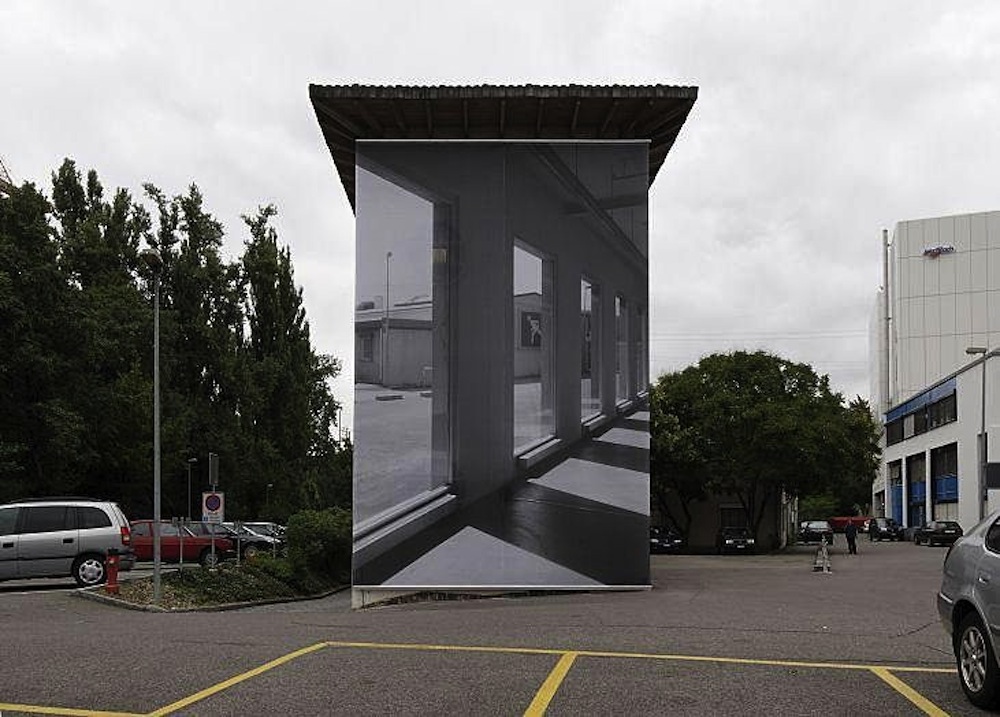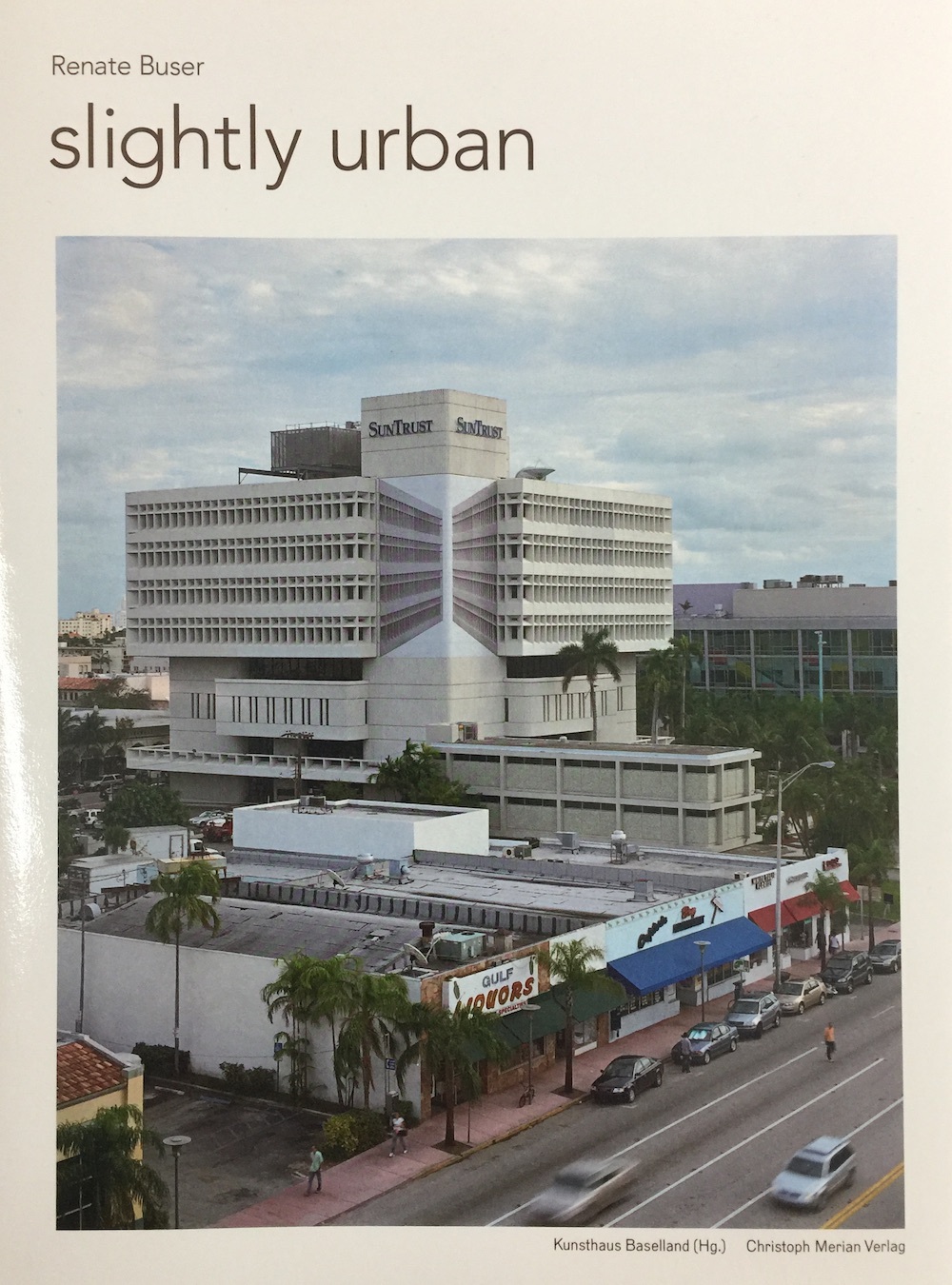Renate Buser
12.8.2007 —
31.12.2008

Renate Buser (born in 1961 in Barmelweid/Aarau, lives and works in Basel) rose to fame primarily with her photographic architectural interventions. In the past few years, her site-specific projects have been carried out in Miami Beach, Lausanne, Biel, Fribourg, Ottawa, and Basel.
Kunsthaus Baselland organizes the first comprehensive show devoted to this artist that features both interventions created on site (referring to the architectural environment of the Kunsthaus) and works that convey the conceptual and contextual background of Buser’s approach.
Buser’s oeuvre is a fertile breeding ground for various photographic approaches and applications. Thanks to the photographs made on site, she renders visible neglected spatial relationships, lines, and structural connections.
She interferes with existing architecture and creates her own distinct version by means of photography, a version that highlights the particularity of the place. The results of these architectural analyses, i.e. large-format photographs, are transferred to textile or paper substrates and then used in the analogous places of the real-life architecture whose inherent structures allow for entirely new architectural variants. The façade of Kunsthaus Baselland facing the street, for example, is virtually changed by means of a photographic trompe l’oeil of the internal space behind it. Rather than the solid wall with the Kunsthaus lettering, viewers, as they look out from the inside, see the window front characteristic of this part of the building as well as slivers of impinging light. The photographic intervention makes the box-like building structure open up, and visitors are guided to the main entrance by the stripe markings of window and light zones.
Three further photographic architectural interventions carried out specifically for Kunsthaus Baselland emphasize and further develop what exists. This exercise then accentuates it even further, or the real locus is shifted by a few meters. The upper left gallery, for example, is emphasized in its extreme angular definition by means of photographic “around-the-corner guidance”. The window front in the “finger” room is “bent” and redirected by almost 90 degrees. A new oblong spatial aperture and row of windows is created exactly where there used to be two real additional windows. The protruding balcony-like gallery, which cuts through the height of the ground-floor level, is photographically shifted into a niche by the artist, and this turns the architectural projection in the opposite direction. Never before has the architecture of Kunsthaus Baselland been the subject of such in-depth artistic investigations. Rooms, which, when handled artistically, always constitute a daunting challenge, are confronted with themselves in Buser’s interventions.
Apart from these Kunsthaus interventions, the exhibition also includes Buser’s first as well as last in-situ work. In 1992 she created “Déjà vu” in collaboration with Ursula Gillmann. At a pre-selected point of a high-rise apartment building, the artist attached a photo of the living room positioned directly behind it. High up, a fictitious window was thus opened up to what really existed. The exhibition shows the original photo next to a documentary picture. Buser’s photographic architectural interventions, which are invariably limited in time, linger on in the documentation; the latter has an archiving function but it is also a work in its own right. One of Buser’s recurrent topics—articulating the contrast between inside and outside—is already quite apparent in this early work. In “Tower piece“ (2006/07) she directs the architectural corner turned to the outside inwardly. In contrast to the earlier work, however, she does not just affix the photograph to the building but actually works on its inherent structure by photographically modifying it, further refining the principle she first applied in 1992. A third type of her works can be subsumed under the heading of classical architectural photography—front views usually processed on Baryt paper. No need to further edit these photographs—they create their own distinct atmospheres.
The exhibition shows “Rue de Acacias“ 2007, “Shimbashi Station” 2007, and “Gropiusstadt” 1999/2007. The outcome is decidedly different whenever Buser manipulates photos directly. Photographs mounted on aluminum in varying formats are bent along existing structures and lines at different angles. In these works too, the artist “builds” and stresses what already exists, such as in the large-format object providing views of Kunsthaus Baselland—what is found in real life is greatly accentuated. The exhibition is complemented by a number of video documentaries that capture the motions underlying her architectural interventions.
An additional video installation entitled “Vers demain“ 1996/2000, originally filmed on Super 8, offers views from aboard a ship. Here the artist toys with the idea of an alleged lack of perspective, while adopting a perspective herself. The film portrays the conceptual point of departure of an artist “who combines cross-fading effects reminiscent of Thomas Struth’s nocturnal projections of photographic views of Münster onto its firewalls when sculptural projects were presented there in 1987 with the eruptive gestures of Gordon Matta-Clark. With her photographic interventions Renate Buser is biding her time. She responds to the widespread trend of photography to capture architecture in real time by disrupting the built structure by forms, but even more by resorting to non-simultaneity generated by an interlacing of views and real buildings from different epochs.” (Hans Rudolf Reust, Kunstbulletin 12/2005).
Text by Sabine Schaschl
